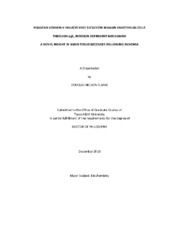| dc.description.abstract | Stroke is the leading cause of long term disability and the third leading cause of
death in the United States. Perlecan plays a significant role in brain development by
sequestering and delivering growth factors to developing neuronal precursor cells in a
neurovascular niche. Previous results demonstrated that perlecan proteolysis results in
the cleavage of perlecan’s most C-terminal domain five (DV) in the post-ischemic brain.
As post-stroke angiogenesis is an important step in post-stroke brain repair, I focused
on the mechanism of DV’s role in brain angiogenesis in vitro.
I first demonstrated that DV significantly increased brain endothelial (BE) cell
migration, proliferation and tube-like formation suggesting DV is a pro-angiogenic
factor for BE cells. I next investigated VEGF secretion from BE cells in the presence of
DV. DV significantly increased VEGF secretion into the cell media, which was both dose
and time dependent. Using quantitative real-time PCR, DV induced a maximal nine-fold increase in VEGF expression, compared to control, indicating DV is an upstream
regulator of VEGF transcription. DV treated cells show an increase in phosphorylation
of ERK-(1/2) that could be blocked by the pharmacological inhibitor U0126. This
inhibitor could also block DV’s effect on VEGF mRNA expression and secretion
indicating ERK is involved with DV’s effect on VEGF regulation. Optical sensor binding
assays confirmed that DV binds to the α5β1 integrin with a Kd of 160nM, and cells
treated with DV showed a visual representation of integrin α5β1-DV colocalization.
Furthermore, shRNA-mediated knockdown of integrin α5 blocked DV’s effect on VEGF
mRNA expression, indicating integrin α5 is involved with DV’s regulation of VEGF
expression.
In conclusion, these results demonstrate that DV has an unexpected proangiogenic
effect in brain angiogenesis. This occurs via a previously unreported
interaction between DV and the α5β1 integrin, resulting in the activation of the ERK,
eIF4A and HIF1α signaling pathway and an ultimate increase in VEGF mRNA expression
and VEGF secretion. As DV is generated post-stroke, these results suggest a novel
mechanism by which brain tissue recovery following ischemia is influenced by
processed fragments from the extracellular matrix. | en |


